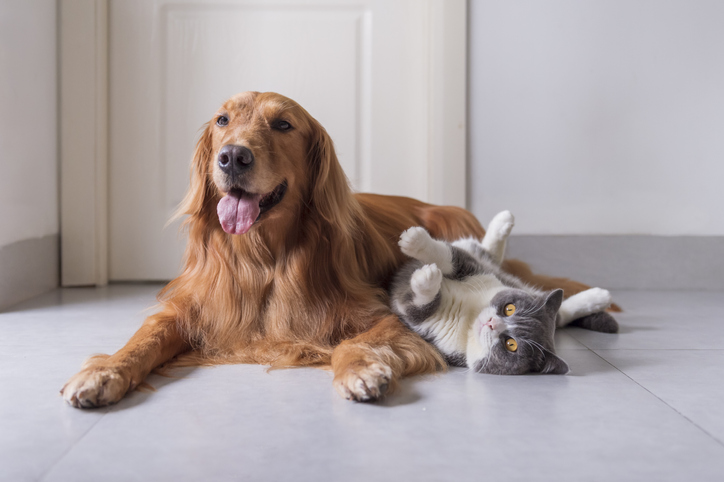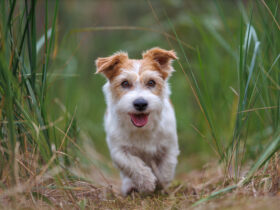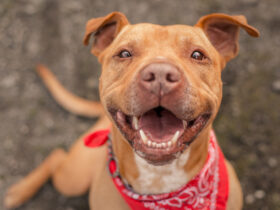The debate between dog and cat people over which animal is better has gone on for decades, but that doesn’t mean you have to choose sides. Despite what Hollywood may have you believe, when you introduce a dog to a cat correctly, they can happily coexist. What matters is that you take the right steps.
While many people believe cats and dogs have a bad reputation of not being able to cohabitate, the introduction process is not as complicated as you may expect. According to Professional Animal Trainer and TV Show Host Joel Silverman, introducing a dog to a cat can actually be a simpler process than having two dogs meet for the first time. However, it’s critical to make sure that your new furry friend meets the resident pet on good terms. Here’s what you can do to help make your four-legged friends start off on the right paw.
Making a Paws-itive First Impression
Ensuring a positive first meeting between your dog and cat is important. According to Silverman, the dog will generally be the dominant personality when two pets meet, whether the dog is the newest family member or not. A bad first impression can make the process of introducing a dog to a cat significantly more complicated.
“There are a lot of dogs that could have been good with other pets, but they were introduced the wrong way,” Silverman says. “The best way to avoid bad situations from happening is to not give them the opportunity to happen. If the dog goes after the cat – whether it’s play in the dog’s mind or aggression – all bets are off because the dog is going to scare the cat.”
Although these can be natural tendencies, it’s crucial that you take some precautions when your dog and cat meet.
Control the situation
When it’s time to introduce a dog to a cat, Silverman suggests having the two meet in a controlled situation where the cat is free to roam and the dog is on a leash. The leash will allow you to hold your dog back in case they have the urge to go after the cat.
“When you get in a controlled environment, you see how the dog reacts,” Silverman says. “If he’s pulling and lunging and wants to go over to where the cat is, that’s not a good time to let the dog go.”
It’s important to note that a dog may be calm at first, but you should keep a hold on the leash just in case something triggers the dog to lunge at the cat. All dogs are different, but the leash gives you a sense of security. If your dog repeatedly pulls on the leash, Silverman suggests using some light corrections to help teach them that pulling is not okay and to not chase after the cat.
Use small sessions to introduce dogs and cats
Once the first impression went well, you’re going to want to replicate those results over multiple sessions. Over time, you can start to relax your restrictions on your dog. If they are behaving well, you can let them get a little closer to the cat while keeping them on a leash.
Eventually, you can let your dog stay a few feet away and let the cat take it upon themselves to come up to the dog and explore each other nose to nose. Sometimes they’ll meet each other and just go in different directions. This is a sign that the two are comfortable with each other.
If your dog shows enough progress, you can begin to loosen your restrictions with the leash. After two or three 15-to-20-minute sessions without any issues, let the leash drag on the ground. This will still allow you to grab the leash if your dog gets too excited. When you feel your dog is consistent with their behavior, you can introduce your dog and cat off the leash.
Give Them Time to Get to Know Each Other
It’s important to note that there is no set amount of time that it takes to introduce a dog and a cat. You should give them as much time as necessary for them to get comfortable. Every four-legged friend is different, so it all depends on your pets’ personalities.
“Things like this take time,” Silverman says. “A lot of people are impatient and want a quick fix, but certain cats and dogs need more time to adjust than others. It’s not necessarily like training your dog to sit or lie down.”
For example, high-prey drive dogs like Australian Shepherds and Border Collies will likely need more time than others. These dogs tend to be more sensitive to elevated sights, sounds, and odors, so they’ll be more excitable around other animals and movement. In this case, the introduction is going to be challenging for your dog, so prepare yourself for multiple sessions to help your pup adjust to having a cat in the house.
On the flipside, a cat that tends to hide can make your job easier. In this case, hiding is something that’s natural to cats, so you can still take the same steps with the leash and turn the dog loose a little sooner if the dog behaves.
Of course, there are times where a dog and a cat may just not get along. If you introduce a dog and cat and either of the animals is continuously aggressive toward the other, this may require separate quarters altogether or may not be a good fit for your family. Fortunately, most animal shelters and humane societies will inform you if an animal that’s up for adoption is good with other pets, so pay attention to those signs when you’re looking to add another furry friend to the family.
—
The preparation doesn’t stop once your dog acclimates to your cat. Not only do you need a litany of supplies to make sure your dog is ready for their new home, you also need to plan for the future. Join our Best Friends Club today to receive special training tips, informative articles, and members-only discounts on Bil-Jac products to stay up-to-date on what you can do to make sure your precious pooch is ready for a long, happy life.







Leave a Reply